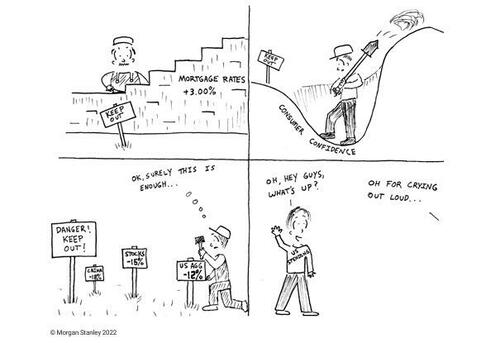Morgan Stanley: TINA Has Left The Building
By Andrew Sheets, chief cross-asset strategist at Morgan Stanley,
Narratives change quickly. Just a month or two ago, it was conventional wisdom that a global recession was already under way. Growth in the US and China contracted in the second quarter of this year and the situation in Europe hardly seemed better. US consumer confidence was near March 2009 lows. The playbook looked clear: after aggressive policy tightening, central banks would stop soon. We were near a ‘pivot’ in policy.
But just a few months later, it looks as if something else has been going on. Year to date, the US economy has added 3.5 million jobs and US manufacturing activity has expanded each and every month. Despite higher rates, higher energy prices, conflict in Europe, and a host of other challenges, the world’s largest economy continues to trundle along.
That possibility came into sharp focus this week with a US core CPI print well above expectations. The CPI number has implications for monetary policy but also raises a much broader question about where we are in the cycle. The market is still facing late-cycle conditions: inflation that is too high, policy that is tightening, a yield curve that’s inverted, and a slowdown in growth that is ahead not behind.
Indeed, exactly what the Fed will need to do to slow down these inflationary pressures seems increasingly uncertain. My fellow Americans love to point out the challenges the ECB faces in crafting a single monetary policy for the diverse economy in Europe. But maybe the Fed is facing a similar dilemma.
Per my colleague Sarah Wolfe in US Economics, about half of all the income in the US is earned by households making more than $100,000 per year. Most of these households own their own homes, and either have no mortgage or have refinanced into a 30-year fixed-rate mortgage at an extremely low rate. This means that the largest expense for these households is not rising even as the Fed is hiking, but their wages are (median wage growth in the US is ~6.5%, per the Atlanta Fed). For many of these households, which represent a large share of national income, financial conditions aren’t tightening, they’re easing. This may help to explain why core inflation is so ‘sticky’ on the way down.
Of course, things look different at the low end of the income distribution, where households are more likely to face high rent inflation and be more impacted by higher food and energy costs. This seems to present a real dilemma, one that in the market’s eyes increases the likelihood that the Fed will have to do more. It is too early to pivot.
For markets, this has a number of implications.
Psychologically, it means adjusting to a world where the Fed no longer seems as friendly and market supportive. Over much of the last 12 years, with inflation undershooting targets, central banks were often happy to push for easy policy when conditions looked tough. But with inflation now high in the US, the UK and the eurozone, that dynamic has changed. Prior to last week, the ECB had never executed a 75bp rate hike. Market pricing now suggests a high likelihood that it will do so in back-to-back months.
Meanwhile, for much of the last 12 years, it was common to hear some variation of ‘TINA’ (There Is No Alternative), the idea that one needed to be long stocks and bonds because cash offered so little. Low yields were not the primary reason why stocks rallied over that time; global equities and global equity earnings simply rose by the same amount (~100%). But was TINA a helpful mental crutch for markets, especially in times of stress? Absolutely.
These tighter policy rates are now scrambling that mindset. Six-month US T-bills yield about ~3.75% and, as we discussed last month, cash and short-term fixed income increasingly offer lower volatility and high yield within a cross-asset portfolio. US 1- to 5-year credit yields ~4.9% against an S&P 500 earnings yield of ~5.9%. But over the last 30 days, the S&P 500 has been 5.7 times more volatile.
In short, investors now have a number of higher-yielding, lower-volatility alternatives if they want to step back from the market. We think this helps to support USD (where yields are the highest), keeps my colleague Mike Wilson cautious on US equities and leads us to see credit outperforming equities in the US and emerging markets.
Tyler Durden
Sun, 09/18/2022 – 12:30
via ZeroHedge News https://ift.tt/HVFlf5I Tyler Durden
